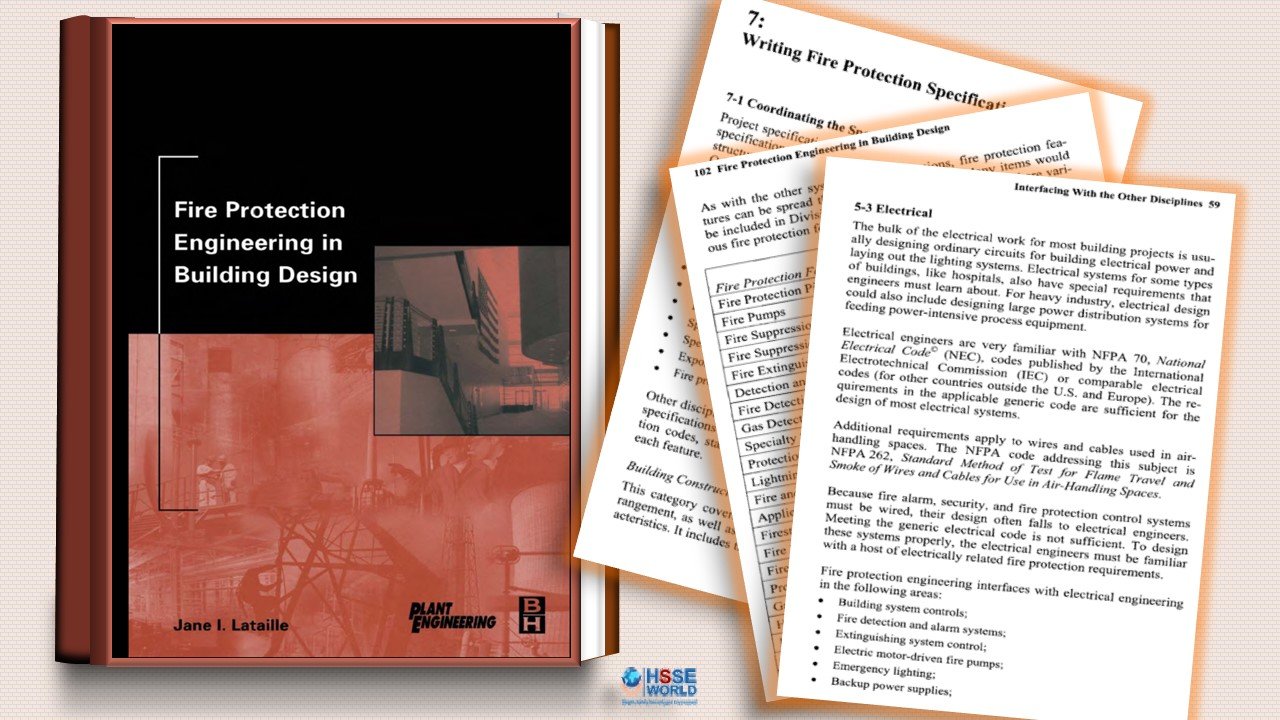Fire Protection Engineering in Building Design by Jane I. Lataille. A clear and concise reference guide on integrating fire protection design, Fire Protection Engineering in Building Design encompasses not only the basic information on the functions, design, and applications of fire protection systems; but also reveals how this information can and should be integrated with every other major engineering discipline. Protecting people, buildings and the environment from the impact of fire requires a comprehensive, systematic approach that includes the analysis of fire hazards as well as the design, installation, and maintenance of fire detection, suppression, and communications systems. Jane Lataille takes the reader beyond these basic issues and includes information on mitigating potential fire damage through proper design and construction of buildings, industrial processes, and utility systems. Through specific examples, the reader sees how fire protection engineering can be integrated with mechanical, electrical, structural, and chemical engineering. The book also includes a section on writing fire protection specifications as well as a comprehensive reference list. * Assure effective fire protection design through engineering * Avoid costly fire protection redesign * Effectively integrate fire protection features into project specifications.
Fire protection is an integral part of the built environment. As such, it should always be engineered in conjunction with the overall building design. Multi-discipline engineering firms sometimes have engineers of other disciplines design the fire protection systems; sometimes they outsource the fire protection design to engineering consultants. Either option can result in inefficiency, improper design, or excess cost if not properly coordinated.
Fire protection design was once almost exclusively prescriptive. In other words, projects incorporated specific fire protection measures prescribed by codes. Prescriptive fire protection design is still commonly used on many projects.

Engineers in disciplines other than fire protection are often charged with designing the fire protection in accordance with prescriptive code requirements. Proper design of fire protection systems for a prescriptive-type project requires coordinating the fire protection design with the overall building design and integrating the fire protection design features with the other engineering disciplines. Fire protection features that are not designed while a building is being planned can sometimes be very difficult to incorporate later. Adding these features later increases the cost.

leaving them out compromises the level of protection provided in the building.
In contrast with prescriptive design, performance-based fire protection design considers how fire protection systems perform given the selected building design and its expected fire loading. Performance-based fire protection design is steadily becoming more common. This type of design requires very close coordination with the building design because every change specified to the building can affect fire protection system performance. Following prescriptive code requirements and coordinating them with the other engineering disciplines is not sufficient.
Contents
Table of Contents of Fire Protection Engineering in Building Design
- he Importance of Integrating Fire Protection Design
- The Professional Society
- What FPEs Do.
- How Fire Protection Engineering Differs
- Preventing and Protecting Against Fire
- Reasons for Installing Fire Protection Systems
- Fire Risk and safety law and its practical application
- Protecting Assets.
- Relating Design Features to Function.
- Design Elements
- Fire Science.
- Design Fire Scenarios.
- Other Design Considerations.
- Examples of Performance-Based Design
- Fire Safety Management Handbook 3rd edition
- Prescriptive Codes.
- Traditional Project Specifications
Download the book
More Downloads
- E-Books: Healthcare Hazard Control & Safety Management
- E-Books: Safety, Health and Working Conditions Training Manual
- E-Books: Energy Efficiency in Water and Wastewater Facilities
- E-Books: Fire Service Features of Buildings and Fire Protection Systems
- E-Books: Evaluation of Fire Safety free download
- E-Books: PPE for Chemical, Biological, and Radiological Hazards free
- E-Books: Changing the Workplace Safety Culture free download
- E-Books: Site Emergency Planning Workbook
- E-Books: Load Restraint Guide
- E-Books: Essential Practices for Creating, Strengthening, and Sustaining Process Safety Culture
- E-Books: System Safety Engineering and Risk Assessment
- E-Books: Permit-Required Confined Spaces
- E-Books: Is it Safe to Enter Confined Space?
- E-Books: 5-Minute Workplace Safety Talks
- E-Books: Safety Culture and High-Risk Environments
- E-Books: Practical Guide to Industrial Safety
- E-Books: Slip, Trip, and Fall Prevention for Healthcare Workers
- E-Books: Health and Safety at Work Key Terms
- E-Books: Fundamentals of Process Safety Engineering
- E-Books: Gas Detection Hand Book
- E-Books: Occupational health and safety management systems ANSI-AIHA-z10-2012
- E-Books: Hot Work on Drums and Tanks
- E-Books: Human Fatigue Risk Management
- E-Books: Guidelines for the provision of facilities and general safety in the construction industry
- E-Books: Handbook of Training in Mine Rescue and Recovery Operations ( 2021)
- E-Books: Code of Practice for the Safe Use of Lifting Equipment – Edition 9 (Nov 2019)
- E-Books: Free Forklift Health and Safety Best Practices Guideline
- E-Books: Handbook of Hazardous Chemical Properties
- E-Books: Human Performance Improvement through Human Error Prevention
- E-Books: Principles Of Fire Risk Assessment In Buildings
- E-Books: Investigation of Occupational Accidents and Diseases
- E-Books: Radiation Protection and Safety in Industrial Radiography
- E-Books: Basic Guide to System Safety, Third Edition
- E-Books: Food Safety Management-A Practical Guide for the Food Industry
- E-Books: Safety identification: Escape and evacuation plan signs- ISO 23601
- E-Books: Safety at Work
- E-Books: The Safety-Critical Systems Handbook 4th edition
- E-Books: Fundamental principles of occupational health and safety
- E-Books: Fire Safety Risk assessment Guide – Sleeping Accommodation
- E-Books: Mental health at work series
- E-Books: Live Fire Training: Principles and Practice
- E-Books: Pre-Startup Safety Review Guide
- E-Books: Fire and Emergency Drill Manual and Building Inspection Guide
- E-Books: Health and Safety: Risk Management 5th edition
- E-Books: Fire Protection systems -Third edition 2021
- E-Books: Fire Safety Logbook templates
- E-Books: From Accidents to Zero
- E-Books: Electric Safety Practice and Standards
- Your steps to chemical safety
- E-Books: Ergonomics and Psychology Developments in Theory and Practice
- E-Books: HAZOPS Should BE fun-The Stream-Based HAZOP
- E-Books: Safety Health and Environmental Auditing
- E-Books: A Quick Guide to Health and Safety
- E-Books: Occupational Ergonomics A Practical Approach
- E-Books: Job Hazard Analysis A Guide for Voluntary Compliance and Beyond
- E-Books: Electrical Safety of Low Voltage Systems




